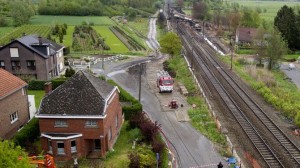Five tank wagons carrying acrylonitrile and one tank wagon carrying butadiene in a 13-wagon train derailed at 2:00 a.m. Several hundred meters of acrylonitrile caught fire, releasing thick smoke into the air. One local resident died of smoke inhalation and one home was destroyed. Belgium’s industrial firms implemented the Belintra protocol in order to assist the authorities in responding to the accident (provision of fire-suppression equipment, neutralizing agents, measuring instruments, and assessment resources).
Two thousand people were evacuated within a 500 -m radius; 391 local residents and six firefighters were taken to hospital. Of these, seventeen were treated for smoke inhalation, including two with severe smoke inhalation injury (more than two days in hospital). On 6 May, the evacuees were able to return to their homes. They were instructed to ventilate them thoroughly and let the taps run in order to flush out the acrylonitrile. However, 200 were re-evacuated after acrylonitrile was detected in a sewer leg that the town authorities were unaware of. Fifty people living within less than 50 m of the accident and 120 residents living near a contaminated well (concentration of 660 ppm) were not allowed to return home until 22 May.
Once the area was secured, one wagon of acrylonitrile was righted with its load. Four others were emptied and the butadiene was burned on site. The six wagons were taken away on 13 May. According to the entity in charge of managing the infrastructure, 350 m of track were destroyed and the damage was in excess of €3.5m.
The volume of extinguishing water that exceeded the capacity of the local wastewater treatment plant (WWTP) was discharged into the Escaut River on 5 May after being diluted to below the health hazard threshold. It was then loaded into tankers. The WWTP was operational after being neutralized with sodium bisulphite on 17 May. Eight piezometers, fitted on 12 May, indicated that the ground was polluted to a depth of 10 m and that the groundwater was polluted as well.
On 19 May, the Public Health branch of Belgium’s Federal Public Service launched an epidemiological study (blood and urine samples). The study involved 1000 people divided into four groups (persons admitted to hospital, emergency response teams, residents living within 250 m, residents living beyond this distance). The Red Cross collected separate blood and urine samples in anticipation of a lawsuit.
According to the initial findings of the investigation, the train was travelling at a speed of 87 kph instead of the 40 kph required at turnouts. The press reported that there were doubts about allowing freight trains loaded with hazardous substances to go through town and about the effectiveness of the emergency-response plans (a number of homes located within the evacuation area had not been searched to look for victims until several days after the accident).




